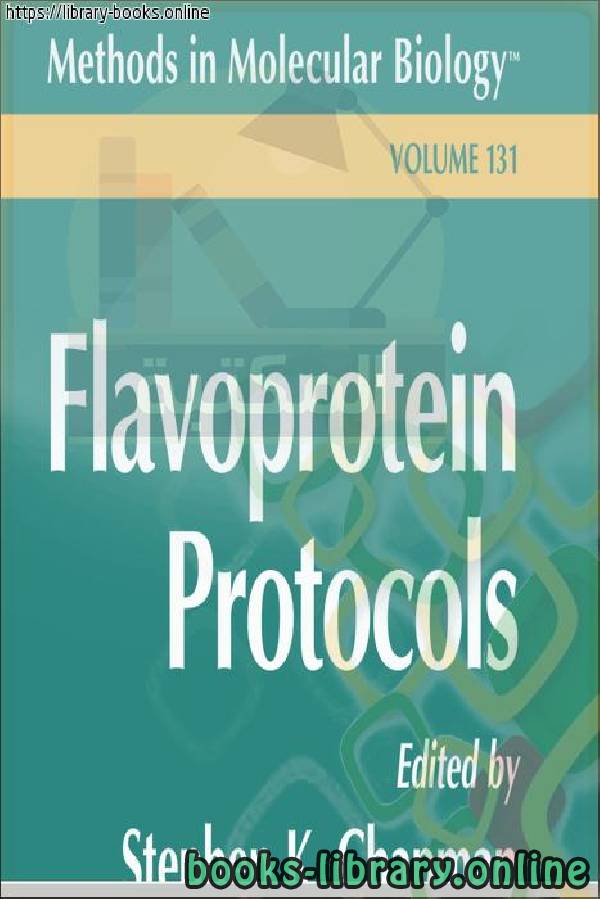📘 قراءة كتاب ( Reid-Flavoprotein Protocols-Humana Press (1999) أونلاين


Biologically
Biology is a natural science that is concerned with the study of life, its various forms and its function, how these organisms interact with each other and with the surrounding environment. The word biology in Greek is made up of two words: bio (βίος) meaning life. And loggia (-λογία) means science or study. Biology: the similarity of vegetation and animal cover on the edges of the African and American states, and the existence of the same fossil.
Branches of biology
Biology is an ancient science thousands of years old and modern biology began in the nineteenth century. This science has multiple branches. Among them are:
Anatomy
Botany
Biochemia
Biogeography
Biofisia
Cytology or cell science
Ecology or environmental science
نبذه عن الكتاب:
The essential cofactor of flavoproteins is derived from riboflavin (Fig. 1),
which consists of the isoalloxazine ring system with a ribityl side chain attached
to the central N-10 position in the pyrazine moiety.
This precursor is phosphorylated at the 5'-hydroxyl group by flavokinase to
yield flavin mononucleotide (FMN). In a second ATP-dependent reaction, FAD
pyrophosphorylase attaches an AMP moiety to FMN yielding flavin adenine
dinucleotide (FAD). Both cofactors are widely distributed in nature. The side
chain plays an important role in binding of the flavin ring system to the protein
and therefore the majority of flavoproteins have a strong preference for either
FMN or FAD. On the other hand, riboflavin does not play a general role as a
cofactor in flavoenzymes. In addition to the noncovalent binding of the flavin
to the protein, covalent linkage to an amino acid residue via the 8- or 6-position
of the isoalloxazine ring system is also found (see Chapter 13). In all cases, the
mechanistically relevant moiety is the isoalloxazine ring system that serves as
a reversible reduction-oxidation catalyst in many biological redox processes
(for a review see: (1,2)). This is also the structural component of the flavin
cofactor that is responsible for light absorption in the UV and visible spectral
range giving rise to the yellow appearance of the flavin and of flavoproteins
(Latin: flavus = yellow). In the oxidized form of the flavin two peaks at ≈ 360
and ≈ 450 nm are observed (see Fig. 2). Method 1 describes a procedure to
determine the extinction coefficient for a flavin bound to a particular flavoprotein which is based on the known extinction coefficient for free FMN and
FAD (12,500 and 11,300 M–1 cm–1, respectively). Binding of the flavin to
the protein moiety alters the extinction coefficient covering a range from
Biology
Human biology
Who is the founder of biology?
The importance of biology
Areas of work in the field of biology
Theories of biology
Research on biology for the first grade of secondary school
Human biology
حجم الكتاب عند التحميل : 1.218 .
نوع الكتاب : pdf.
عداد القراءة:
اذا اعجبك الكتاب فضلاً اضغط على أعجبني و يمكنك تحميله من هنا:

شكرًا لمساهمتكم
شكراً لمساهمتكم معنا في الإرتقاء بمستوى المكتبة ، يمكنكم االتبليغ عن اخطاء او سوء اختيار للكتب وتصنيفها ومحتواها ، أو كتاب يُمنع نشره ، او محمي بحقوق طبع ونشر ، فضلاً قم بالتبليغ عن الكتاب المُخالف:
 قبل تحميل الكتاب ..
قبل تحميل الكتاب ..
يجب ان يتوفر لديكم برنامج تشغيل وقراءة ملفات pdf
يمكن تحميلة من هنا 'http://get.adobe.com/reader/'


 منصّة المكتبة
منصّة المكتبة 